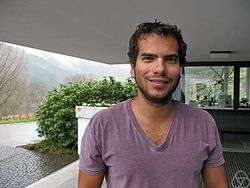Artur Avila
| Artur Avila | |
|---|---|
|
Avila in Oberwolfach in 2012. | |
| Born |
29 June 1979 Rio de Janeiro, Brazil |
| Residence |
Rio de Janeiro, Brazil Paris, France |
| Citizenship | Brazilian and French[1] |
| Fields | Mathematics |
| Institutions |
IMPA, CNRS Paris Diderot University (Paris 7) Instituto Nacional de Matemática Pura e Aplicada |
| Alma mater |
Instituto Nacional de Matemática Pura e Aplicada(Ph.D. and M.S.) Federal University of Rio de Janeiro (B.S.) |
| Thesis | Bifurcações de tranformações unimodais sob os pontos de vistas topológico e métrico (2001) |
| Doctoral advisor | Welington de Melo |
| Doctoral students | Xiaochuan Liu, Maria João Resende, Disheng Xu, Zhenghe Zhang |
| Known for |
Dynamical systems Spectral theory Zorich–Kontsevich conjecture Ten martini problem |
| Notable awards |
Fields Medal (2014) Michael Brin Prize in Dynamical Systems (2011) EMS Prize (2008) Salem Prize (2006) Gold medal at the International Mathematical Olympiad (1995) |
Artur Avila Cordeiro de Melo (born 29 June 1979) is a Brazilian and French mathematician working primarily on dynamical systems and spectral theory. He is one of the winners of the 2014 Fields Medal,[2] being the first Latin American to win such award. He is a researcher at both the IMPA and the CNRS (working a half-year in each one).
Biography
At the age of 16, Avila won a gold medal at the 1995 International Mathematical Olympiad[3] and received a scholarship for the Instituto Nacional de Matemática Pura e Aplicada(IMPA) to M.S. even when studying the average education at the Colégio de São Bento and Colégio Santo Agostinho in Rio de Janeiro,[4] graduated in Federal University of Rio de Janeiro(UFRJ) even when studying he got his PhD when he was 21 years old again by IMPA.[5]
At 19 he began his doctoral thesis on the theory of dynamical systems. Completed in 2001, when he traveled to France to do post-doctoral.[6] It works in the areas of dimensional dynamic and holomorfa.[7] Since 2003 works at the Centre National de la Recherche Scientifique (CNRS) in France, and since 2008 is Directeur de recherche at this property. His post-doctoral supervisor was Jean-Christophe Yoccoz.[8]
Considered a prodigy as a teenager in 2005, at age 26, Arthur became known among mathematicians can prove by the "Conjecture of the ten martinis" problem proposed in 1980 by the American Barry Simon. Simon promised to pay ten martini doses who explained his theory about the behavior of "Schrödinger operators", mathematical tools related to quantum physics. Artur solved the problem with mathematics Svetlana Jitomirskaya [9] and was presented with a few rounds of martini.
Prizes
Later, as a research mathematician, he received in 2006 a CNRS Bronze Medal as well as the Salem Prize, and was a Clay Research Fellow. He became the youngest Professorial Fellow (directeur de recherches) at the CNRS in 2008. The same year, he was awarded one of the ten prestigious European Mathematical Society prizes, and in 2009 he won the Herbrand Prize from the French Academy of Sciences.
He was a plenary speaker at the International Congress of Mathematicians in 2010.[10] In 2011, he was awarded the Michael Brin Prize in Dynamical Systems. He received the Early Career Award from the International Association of Mathematical Physics in 2012[11] and the Fields Medal in 2014.[12]
Mathematical work
In 2005, together with Svetlana Jitomirskaya, he solved the ten martini problem,[13] and together with Marcelo Viana, he proved the Zorich–Kontsevich conjecture.[14]
Notes and references
- ↑ http://www.math.jussieu.fr/~artur/cur.pdf
- ↑ The Guardian
- ↑ Web-site of the International Mathematical Olympiad: Brazil at the 36th IMO (1995)
- ↑ Talarico, Bruna (16 January 2010), "Gênio da matemática carioca", O Dia Online (in Portuguese)
- ↑ Moreira Salles, João (January 2010), "Artur tem um problema", Piauí (in Portuguese), archived from the original on 30 June 2015
- ↑ Vanessa Fajardo (12/08/2014). "Pesquisador brasileiro ganha prêmio equivalente a 'Nobel' de matemática". G1. Check date values in:
|date=(help) - ↑ "Artur Avila". Clay Mathematics Institute.
- ↑ []
- ↑ []
- ↑ "ICM Plenary and Invited Speakers since 1897". International Congress of Mathematicians.
- ↑ The IAMP Early Career Award
- ↑ 2014 IMU Prize Winners
- ↑ http://arxiv.org/abs/math/0503363
- ↑ http://arxiv.org/abs/math/0508508
Further reading
- Lin, Thomas; Klarreich, Erica (12 August 2014). "A Brazilian Wunderkind Who Calms Chaos". Quanta Magazine.
- Moreira Salles, João. "Artur has a problem" (translated from the Portuguese by F. Thomson-Deveaux). Piauí Magazine.
External links
- Artur Avila's home page
- Artur Avila's home page
- Artur Avila's Lattes Platform
- Artur Avila at the Mathematics Genealogy Project
- Claymath fellow page
- "Artur Avila's results". International Mathematical Olympiad.
- Interview with Artur Avila Chalkdust Magazine

